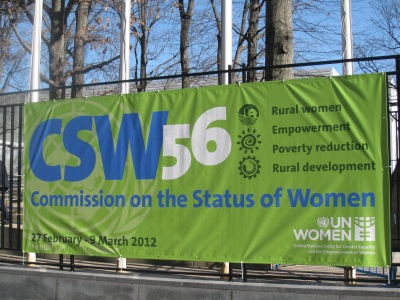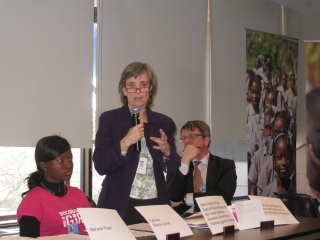
The United Nations 56th Session of the Commission on the Status of Women (CSW 56) featured as its priority theme this year "the empowerment of rural women and their role in poverty and hunger eradication, development and current challenges." This focus on rural women is long overdue, given that rural women comprise a quarter of the world's population. Further, women provide 43% of the world's agricultural labor, and they produce half of the world's food for direct consumption. In fact, non-governmental organizations (NGOs) discovered some time ago that women--referred to by many as the "architects of food security"--are key agents of development. One reason for this is that when women and girls receive income, they reinvest 90% of it in their families. In spite of their transformative potential to reduce hunger and poverty, women own less than 2% of land worldwide and they receive less than 10% of available credit.
As one whose scholarship focuses on rural livelihoods in both the United States and abroad, I was pleased to attend three days of the two-week CSW 56 event (February 27-March 9) as an observer for the American Society of International Law. As a former gender consultant for the United Nations, I was prepared for some of what I saw (e.g., bureaucracy), but the experience also held a few surprises. One thing that intrigued me about the “Session”—which is not a session at all but a dizzying array of “high-level round tables” and other meetings, panel discussions, “side events,” and “parallel events”—is that discussion of law was relatively absent. Furthermore, relatively little of the substance of these gatherings focused on rural women in a way that went beyond adding the modifier “rural” to whatever issue was being discussed. Rather than engaging with the circumstances that often distinguish rural women’s lives from those of their urban counterparts, many of the sessions seemed merely to “add rural women and stir” in relation to a well-recognized (and admittedly very important) women’s issue (e.g., female genital mutilation, child marriage). Other sessions did take up issues more central to rural livelihoods, including spatial removal from services and agents of the state, and women’s roles in agricultural production. The lack of significant engagement with the particular challenges facing rural women is reflected in the fact that none of the resolutions adopted by the Commission was about rural women. Nor did the Commission adopt any agreed conclusions on the priority theme of the 56th Session.
In contrast to CSW’s somewhat anemic approach to the priority theme, Article 14 of the Convention on the Elimination of All Forms of Discrimination Against Women (CEDAW) addresses the rights of rural women as a group. Indeed, CEDAW is the first human rights treaty to recognize rural difference, to acknowledge rural populations. While Article 14 guarantees to rural women all the rights enumerated elsewhere in CEDAW, the article also addresses rights specific to rural women. These include the right:
- to be involved in “development planning at all levels”;
- to benefit from “all community and extension services” among other types of education;
- to “organize self-help groups and cooperatives in order to obtain equal access to economic opportunities”;
- “to have access to agricultural credit and loans, marketing facilities, appropriate technology and equal treatment in land and agrarian reform, as well as in land resettlement schemes”; and
- “to enjoy adequate living conditions, particularly in relation to housing, sanitation, electricity and water supply, transport and communications.”
Read more about Article 14, its history, and its implementation here, here, and here. Given the particular attention paid to rural women in this germinal women’s rights treaty, one might have anticipated considerable attention to the provision and its potential at CSW 56. Not so at the sessions I attended. I heard Article 14 mentioned only a couple of times.
It is a common bias among lawyers to presume law can solve problems and should be used to do so. Lawyers may be more skeptical about whether international law is effective at solving problems, attributing failures to the lack of enforceability of international law and the lack of respect for the rule of law, particularly in the developing world. As a ruralist, I have asserted that law is less effective at addressing problems in rural locales for some similar reasons. That is, when legal institutions and legal actors (including lawyers) are literally less present, laws on the books are less potent and the rule of law withers. All of these issues related to the relevance, authority, and efficacy of law were in play—sometimes explicitly, more often implicitly—in the attention CSW 56 gave to rural women.

Many of the participants in CSW 56 were not lawyers—nor were they UN or national officials. Rather, the vast majority of participants were associated with NGOs that have consultative status with the UN Economic and Social Council. Indeed, on each morning of CSW 56, officials with UN Women held a briefing for NGO representatives (also referred to as “civil society”). By the middle of the first week, UN Women announced that 1,598 NGO representatives from 358 NGOs were engaged in the annual gathering.
At these daily briefings, UN Women officials offered affirmations to NGO representatives, assuring them of the importance of their efforts. The UN officials also offered updates on what was happening at the “high-level meetings” that few NGO representatives had permission to attend. In spite of their exclusion from many of the events where member states were in direct talks, NGOs presented a robust and varied array of panel discussions. A tiny sampling of the topics and their sponsors follows:
- Women and Corruption: Grassroots Experiences and Strategies, Huairou Commission, UN Development Program
- Empowering Caregivers to Build Healthy Sustainable Communities, Huairou Commission, GROOTS International, International Council of Women
- Rural Women's Groups and Key Stakeholders Frame Joint Actions, Government of Norway, Huairou Commission, GROOTS International, UN Women, UN-Non Governmental Liaison Service, Baha'i International Community, Food and Agriculture Organization, International Fund for Agricultural Development, World Food Program, Landesa
- Rural Women Speak: Land, Health and Rights in Africa, FEMNET
- Rural Girls and Urban Migration: The Role of Communications for Development in Bridging the Divide, UN-HABITAT, Plan International, UNESCO, Women in Cities International
- Measuring Change for Rural Women in Sub-Saharan Africa, Global Fund for Women
Here is a link to the official programming, and a full listing of the NGO programming is here.
While most commentators in these parallel and side events presumed developing world contexts, a few offered reminders that biases against women persist in the developed world, too, including in relation to agriculture. In other words, Australia, Canada, the United States (just to name a few) all have work to do to empower women, including those in rural areas. (To be clear, unlike these other nations, the U.S. has never ratified CEDAW and is not bound by it).
This sampling of events demonstrates my earlier points about both the relative absence of attention to law’s role in solving the problems of rural women (and perhaps, by implication, all women), and also the shortage of programming regarding issues unique to rural women. To the extent that the particular concerns and circumstances of rural women were center stage, the focus typically related to agriculture. Among these were issues such as access to credit and means of marketing their products, the relative merits of “sustainable” agriculture versus intensive production agriculture, and an issue that more squarely implicates law: women’s right to own land. Officials from UN Women reported that diplomats participating in CSW 56 were sharing examples of legislation that would achieve land reform and improve land distribution schemes, but in the next breath they acknowledged the challenge of getting these laws implemented and enforced.
The need for legal reform arose in other contexts, too, but so did law’s limitations. For every comment I heard about the utility of Article 14 of CEDAW (or some other progressive national or international law) and the importance of legal and policy environments that were conducive to women’s empowerment, I also heard words of caution about the limits of law. Government and UN officials were more likely to tout the power of law, while NGOs were more likely to focus on village realities that often undermine the rule of law. Among those offering caveats regarding the potency of law were those who noted that many will be reluctant to invoke it—including criminal laws—in relation, for example, to forced child marriage. One African NGO representative stated,
Face reality ... be honest. Even in America, who tells the law? Maybe [the victims and their families] are illiterate ... [child marriage] is their custom. Who goes to tell the law except the child? And how can the child go tell the law?
This is where all of us come in ... if your NGO is interested in solving these problems. You go [to the village], watch the ways things are done and then talk to the educated locals [so that they begin to see the social and economic costs of the practice, e.g., child marriage]. And they will know they must do something.
This woman, like many others I heard over three days, extolled the importance of grassroots efforts to achieve the empowerment of women.
Wherever one might strike the balance between formal law on the one hand and local, grassroots efforts to educate and achieve cultural change on the other, few coming out of CSW 56 would dispute that both have significant roles in empowering not only rural women, but indeed all women.
Originally posted to Jurist.org; cross-posted to Legal Ruralism, IntLawGrrls and Agricultural Law.